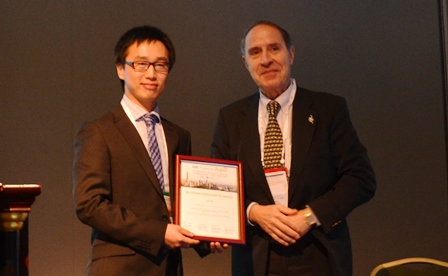Menzies researcher wins international award

Menzies researcher wins international award
A young health economics researcher from the University of Tasmania's Menzies Institute for Medical Research has won an international award for research into the economic impact of osteoporosis in China.
A young health economics researcher from the University of Tasmania's Menzies Institute for Medical Research has won an international award for research into the economic impact of osteoporosis in China.
Mr Lei Si, a PhD student from the Health Economics Research Unit at Menzies, was awarded the International Osteoporosis Foundation Young Investigator Award. His work was chosen from submissions from researchers and clinicians from more than 38 countries.
Mr Si's study is the first to forecast the incidence and costs of osteoporotic fractures in China in the coming decades and was performed using a cost-effectiveness model developed and validated by the Health Economics Research Unit at Menzies.
In 2010, more than 2.3 million osteoporotic hip, clinical vertebral and wrist fractures were estimated to have occurred in the Chinese population aged 50 years or older, costing more than US$9.6 billion to the Chinese healthcare system. Women were estimated to have sustained around four times the number of fractures as men, accounting for 73% of the total costs. It found that osteoporotic fractures and costs are expected to double by 2035 and will continue to increase until 2050.
Osteoporosis is a "silent disease" because a person with osteoporosis can live without apparent symptoms until a fracture occurs. It is estimated that about one in three women and one in five men over the age of 50 will experience osteoporotic fractures.
"Osteoporosis has been listed as one of the National Health Priorities since 2011 in China," Mr Si said. "The good news is that more money will be injected into osteoporotic fracture prevention programs in the future, but the next question is how do we get value for this money?
"Scarcity of health resources means we must have programs that represent good value for money, so we need to undertake more cost-effectiveness studies to identify the osteoporotic fracture preventions with the most health gain and least money spent."
The head of health economics at Menzies, Professor Andrew Palmer, and Professor Tania Winzenberg are Mr Si's supervisors. Researchers from Anhui Medical University and Nanjing Medical University in China have also been involved in the research.
"The model we have developed for the Chinese setting has enormous utility for the rest of the world, including Australia, as it will be adapted to allow global projections of the human and economic costs of osteoporosis-related fractures," Professor Palmer said.
The research was presented last week at the IOF Regional 5th Asia-Pacific Osteoporosis Meeting in Taipei. The study is titled "Projection of Incidence and Economic Burden of Osteoporosis-related Fractures in China: 2010-2050".
Pictured above: Mr Si with Professor René Rizzoli, who is the Scientific Advisory Board Chair of the European Society for Clinical and Economic Aspects of Osteoporosis and Osteoarthritis. Professor Rizzoli is also a member of the International Osteoporosis Foundation Executive Committee.
Information released by:
Miranda Harman
Marketing and Communications Manager
Menzies Institute for Medical Research
University of Tasmania
Phone: 61 3 6226-7751
61 427 199 562
Email: miranda.harman@utas.edu.au
Contact:
Phone:
Email: